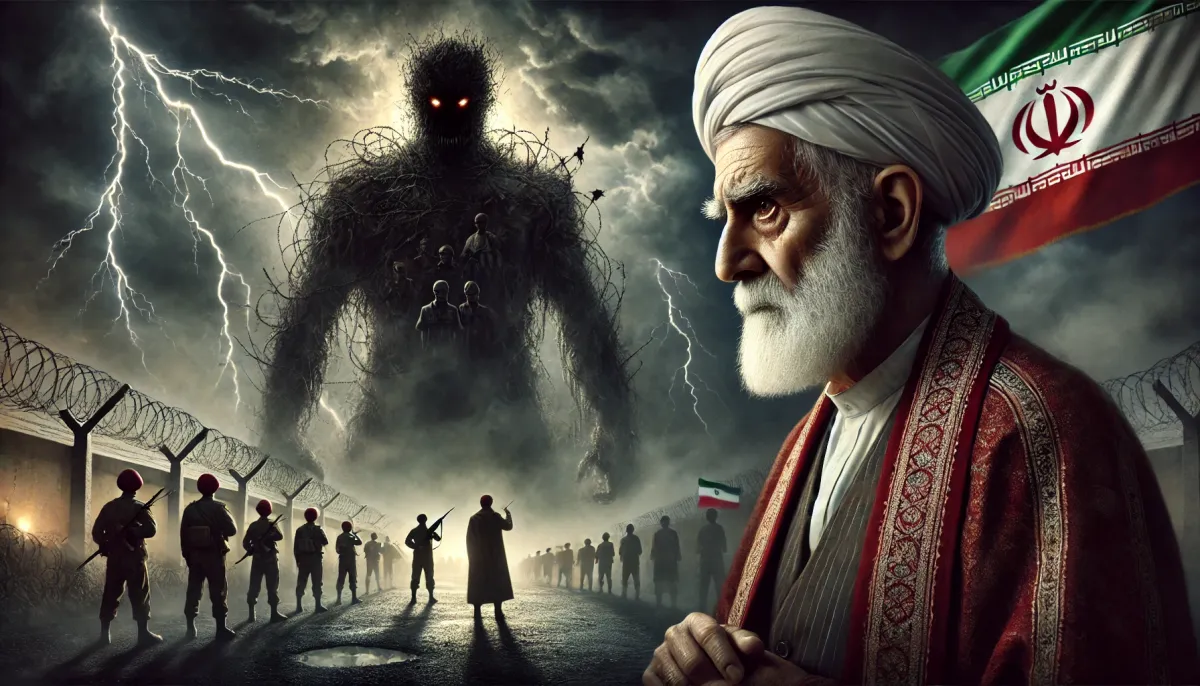

By Dr. Tim Orr
The founder of Iran’s most feared military force, the Islamic Revolutionary Guard Corps (IRGC), sits down with Patrick Bet-David to expose what really happened behind closed doors during the 1979 Iranian revolution.
Mohsen Sazegara, a former insider, reveals how the IRGC transformed from its original mission into a global power player—linked to Hezbollah, Hamas, and international conflicts. What was meant to be a national guard to protect Iran’s sovereignty instead became a sprawling empire of terror, corruption, and repression.
Khomeini’s Return: A Revolution Hijacked
In February 1979, Ayatollah Ruhollah Khomeini stepped off an Air France plane onto the tarmac of Tehran’s Mehrabad Airport, greeted by throngs of jubilant supporters. To the outside world, he was a frail, elderly cleric with piercing eyes and a quiet demeanor. To his followers, he was the long-awaited messiah of Iran’s Islamic revolution, the man who had defied the Shah and his powerful Western backers.
Khomeini spent 14 years in exile, mostly in Iraq and later in France, during which time he built an ideological movement that fused Shi’a Islam with revolutionary politics. His writings and speeches called for overthrowing the Shah and establishing an Islamic government—one where clerics, not elected officials, would wield supreme authority. He had carefully crafted his image as a champion of the oppressed, promising justice, freedom, and an end to Iran’s subservience to foreign powers.
But behind the rhetoric lay a vision far darker than many of his supporters had anticipated. Khomeini believed in an uncompromising theocracy, one that would silence dissent, enforce strict religious laws, and export Iran’s revolution beyond its borders. He wasted no time in dismantling the fragile coalition of liberals, leftists, and nationalists who had helped bring him to power. Within months, mass arrests, purges, and executions became the new order of the Islamic Republic.
One of the young revolutionaries swept up in the fervor of Khomeini’s return was Mohsen Sazegara. As a student activist, he had been imprisoned under the Shah for his anti-government activities. Now, he was among those tasked with helping build the new regime. And one of the first institutions he helped create would become the most feared force in Iran—the Islamic Revolutionary Guard Corps (IRGC).
A Revolution Spirals Out of Control
Sazegara believed in the revolution. He had fought for it, suffered for it, and dreamed of a new Iran free from dictatorship. When Khomeini called for forming a new military force to safeguard the revolution, Sazegara saw it as a necessary step. Iran’s army was fractured, uncertain, and still populated with officers loyal to the Shah. A new guard was needed to protect the Islamic Republic from counter-revolutionaries.
He imagined something like Switzerland’s citizen army or the U.S. National Guard—a force that would defend Iran’s sovereignty while remaining accountable to the people. He never expected that, decades later, he would be living in exile, hunted by the organization he helped build.
The first warning signs came early. After the revolution, weapons flooded the streets. Civilians, including elderly women and teenagers, had looted military garrisons, arming themselves with rifles, grenades, and even bazookas. The new government needed to consolidate control, so one of the IRGC’s first tasks was to go door to door, confiscating weapons from everyday Iranians.
But this was just the start. Within months, ideological purges began. Anyone suspected of opposing the Islamic regime—whether monarchists, communists, or even former allies—became targets.
By 1988, the brutality reached a new level. In a matter of months, Iran’s government executed 4,000 political prisoners—men and women who had already been sentenced, some serving time for nothing more than dissenting opinions. Prisoners were blindfolded and lined up against walls, their names called one by one, and their bodies dumped in mass graves.
For Sazegara, this was the breaking point. He had spent years believing in the revolution, believing that Khomeini’s Islamic government could deliver justice. But now, as bodies piled up, he saw what the IRGC had truly become. "That was a crime," he says, his words heavy with sorrow.
A Revolution Spirals Out of Control
Mohsen Sazegara was among the young revolutionaries who had fought against the Shah. Like many others, he had envisioned a freer Iran. When Khomeini called for creating a revolutionary guard to "protect the revolution," Sazegara saw it as a necessary step to prevent counter-revolutionaries from sabotaging their hard-won victory.
But he was naive.
The IRGC was not designed to be a temporary force. It was not a neutral protector of Iran’s people. Khomeini’s army was built to enforce ideological purity and eliminate opposition.
At first, the IRGC’s tasks were simple: confiscate weapons from civilians, round up members of the deposed Shah’s military, and secure government buildings. But soon, its primary mission became suppression.
- It hunted down former revolutionaries who dared to criticize Khomeini’s growing authoritarianism.
- It carried out mass executions of political prisoners, some of whom had fought alongside Khomeini against the Shah.
- It silenced the press, arresting and torturing journalists who refused to parrot the regime’s propaganda.
By the late 1980s, the IRGC had become more powerful than Iran’s regular army. It was not just a military force; it had its intelligence agencies, businesses, and financial empire. It was answerable only to the Supreme Leader, a shadow government controlling nearly every aspect of Iranian life.
Sazegara, once an enthusiastic revolutionary, began to see the nightmare unfolding. He had believed in justice, but terror had replaced it. He had fought for freedom, but freedom had been crushed under the weight of religious dictatorship.
The Monster Grows Heads
As the years passed, the IRGC transformed into something far more sinister than even Khomeini had envisioned. Today, it is not just a military organization; it is a global empire of violence and corruption, operating far beyond Iran’s borders.
Sazegara describes it as a "seven-headed dragon":
- A military force—The IRGC is stronger than Iran’s conventional army. It has its own navy, air force, and missile program, allowing it to conduct military operations independently of Iran’s government.
- A terrorist organization—Through its Quds Force, the IRGC funds and arms groups like Hezbollah in Lebanon, Hamas in Gaza, and the Houthis in Yemen, fueling regional wars and terrorism worldwide.
- An intelligence agency—The IRGC runs secret prisons, carries out assassinations, and kidnaps dissidents abroad, creating a vast surveillance state that rivals the KGB.
- A mafia—The IRGC controls Iran’s black market, from drug trafficking to oil smuggling, raking in billions of dollars annually while ordinary Iranians suffer under economic sanctions.
- A political force—It dominates Iran’s parliament, judiciary, and presidency, ensuring that true political opposition is never allowed to emerge.
- A nuclear player—The IRGC is the driving force behind Iran’s nuclear ambitions, threatening regional stability and drawing the world closer to war.
- A force of repression—The IRGC is responsible for crushing protests, jailing journalists, and torturing political dissidents, ensuring that Iran remains in a permanent state of fear.
It is not just a military organization but a state within a state. It dictates Iran’s foreign policy, fuels proxy wars, and spreads radical Islamist ideology worldwide.
A Life in Exile, Hunted by His Own Creation
For Sazegara, realizing the revolution had gone wrong was not immediate. It was gradual—a series of betrayals, moments of disillusionment, and nights haunted by the faces of those who had vanished.
His break with the regime became irreversible after the mass executions of 1988 when thousands of political prisoners—many of them arrested as teenagers—were executed in secret. Their families were never told where they were buried. The killings were so systematic that prisoners were lined up, blindfolded, and asked one question: "Do you still believe in your cause?" If they answered yes, they were taken to the gallows.
For Sazegara, it was too much. He could no longer pretend the IRGC was a force for good. He could no longer justify the bloodshed.
But leaving Iran was not easy. He was arrested. He was tortured. He was placed in Evin Prison, Iran’s most notorious detention center, where interrogators use rape, mock executions, and psychological torture to break the human spirit.
He went on a hunger strike, losing 50 pounds in 70 days. He knew if he stayed, he would either be executed or disappear—like so many others.
Today, he lives in exile. But even outside of Iran, he is not safe. The IRGC hunts its enemies across the globe, assassinating dissidents in Turkey, Iraq, and even Europe.
The Lesson of a Revolution That Devoured Its Own
Sazegara’s story is not just one of personal regret. It is a warning to the world. Revolutions do not always lead to freedom. Sometimes, they lead to monsters.
The IRGC was built on good intentions—or so its founders thought. But once you create an unaccountable force answerable only to ideology, it will devour everything in its path.
The IRGC is not just Iran’s problem. It is a global force of instability:
- It funds terrorist organizations that target civilians.
- It assassinates political dissidents across the world.
- It fuels wars in Syria, Iraq, Yemen, and beyond.
- It threatens nuclear war.
And yet, Western governments continue negotiating with Iran, pretending that the IRGC is just another military force.
But Sazegara knows the truth. He built the machine and is doing everything he can to dismantle it.
The question is—will the world listen before it’s too late?
Tim Orr is a scholar of Islam, Evangelical minister, conference speaker, and interfaith consultant with over 30 years of experience in cross-cultural ministry. He holds six degrees, including a master’s in Islamic studies from the Islamic College in London. Tim taught Religious Studies for 15 years at Indiana University Columbus and is now a Congregations and Polarization Project research associate at the Center for the Study of Religion and American Culture at Indiana University Indianapolis. He has spoken at universities, including Oxford University, Imperial College London, the University of Tehran, Islamic College London, and mosques throughout the U.K. His research focuses on American Evangelicalism, Islamic antisemitism, and Islamic feminism, and he has published widely, including articles in Islamic peer-reviewed journals and three books.
